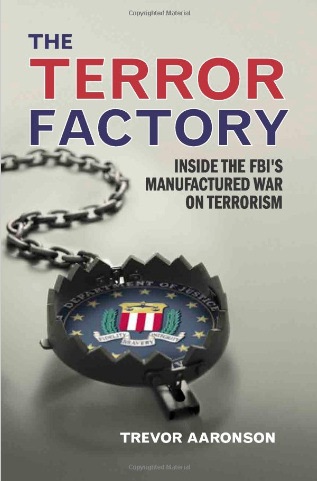 Reviewed: The Terror Factory: Inside the FBI’s Manufactured War on Terrorism, By Trevor Aaronson, Ig Publishing, 2013, 239 pages, hardcover, $24.95
Reviewed: The Terror Factory: Inside the FBI’s Manufactured War on Terrorism, By Trevor Aaronson, Ig Publishing, 2013, 239 pages, hardcover, $24.95
How is it that a couple of kids with crock pots could bomb the Boston Marathon, when counter-terrorism is the FBI’s top priority?
In The Terror Factory, Trevor Aaronson suggests that part of the problem might be the nature of the FBI’s successes. Looking carefully at the Justice Department’s terror prosecutions, Aaronson argues that there is more to such cases than the government suggests — or, rather, that there is less:
According to government and federal court records, the Justice Department has prosecuted more than 500 terrorism defendants since 9/11. Of these cases, only a few posed actual threats to people or property. . . . [M]ore than 150 were caught conspiring not with terrorists but with FBI informants in sting operations. The remainder of the Justice Department’s post-9/11 terrorism prosecutions involved crimes such as money laundering or immigration violations in which the link to terrorism was tangential or on another continent, and no evidence in these cases suggested credible safety threats to the United States.
Disturbingly many of the cases involved an informant acting as an agent provocateur — instigating, facilitating, funding, and then betraying an imaginary conspiracy.
By outlining a few cases, and providing case studies of the careers of some of the FBI’s most prolific informants, Aaronson’s book demonstrates how that happens, and some of why.
In the typical case, a skilled and manipulative informant encounters some unlucky, incompetent, malleable person who talks big about jihad. The informant then mentors this hapless mark, providing him a sense of individual importance — along with a detailed plan, a (fake) bomb, whatever other resources are required, and usually, a considerable about of cash. As far as the target knows, it all comes from some overseas terrorist outfit, but really it is supplied by the FBI. In effect, the FBI finds desperate people with daydreams of a holy war, provides them everything they need — short of actual explosives — and then arrests them. In the name of preventing terrorism, the FBI is literally creating the terrorists it apprehends.
Why this is happening is somewhat trickier. Aaronson’s analysis relies on the logic of bureaucracies and the results-driven culture of the Bureau. The FBI spends $3 Billion on counterterrorism (out of its $8 Billion total budget), and the funding determines the Bureaus priorities — which means that its agents must find terrorists, even if they have to manufacture them before they can find them. Since every new arrest is also a propaganda victory — demonstrating the reality of the terror threat and the Bureau’s heroic efforts to protect us — each new case feeds the cycle by increasing the demand for more investigations.
Aaronson’s account assumes that this circular logic, combined with bureaucratic inertia, sustains the FBI’s entrapment practices, and that the propaganda angle is a collateral benefit. I wonder, however, if we might not do better to think of the propaganda value as the real point. The difference may depend on our level of description. Looking at these cases from the perspectives of the agents managing them, the bureaucratic imperative is obviously central. They’re just trying to do — and keep — their jobs, and terror busts are a good way of impressing their bosses and moving up the ranks. And this explanation may work at the institutional level as well, since the Attorney General and the Director of the FBI surely enjoy the effect counter-terrorism funding has on their budgets.
In terms of political strategy, though, what is the benefit for the state? Aaronson does not take this question up explicitly, but his analysis would suggest that the counter-terrorism money, and the efforts it finances, are wasted. The feds are building and burning straw men while the real-life terrorists and criminals do their work unnoticed. The Boston bombing shows the consequences of this mistake most dramatically.
However, this line of reasoning assumes that the purpose of counterterrorism really is to protect the public. The FBI’s strategy does not do so; therefore the effort is wasted. But what if the point of counterterrorism is to terrorize the public? (That is the implication of the prefix counter-, as opposed to anti-.) In that case, for the state’s purposes, it makes no difference if the people arrested and convicted and jailed in high-profile cases really are terrorist masterminds, or whether they are harmless, if anti-social, fools. News of the arrests has the effect of scaring people. The stories create the impression that terrorists are always lurking and plotting and aiming to hurt you and your loved ones; the only thing keeping you safe is the intervention of the secret police. Along with the not-incidental racism identifying Islam with terrorism, the ideological effect is to legitimize domestic spying.
In 2008, the FBI reported using 15,000 informants — ten times as many as in 1975. Some of these informants are not even looking for terrorists. Instead, they seek out information about immigration violations, minor crimes, financial difficulties, or material for blackmail — any point of leverage that the Bureau can use to recruit more informants.
The fact that terrorism stings actually do nothing to protect the public is irrelevant. Five hundred failed terror plots — even if fictitious — inspires a fear of terrorism and a trust of authority. One actual bombing, more or less, makes no real difference.
Kristian Williams is the author of Our Enemies in Blue: Police and Power in America, and an editor of the forthcoming collection Life During Wartime: Resisting Counterinsurgency. He is a member of the Committee Against Political Repression, in Portland, Oregon.
